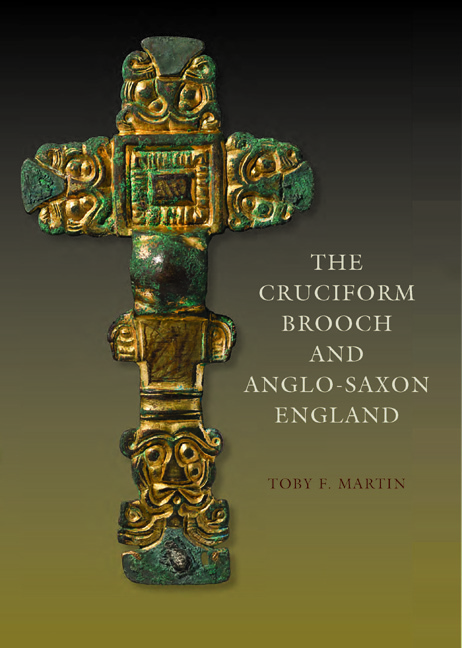Book contents
- Frontmatter
- Dedication
- Contents
- List of Illustrations
- Preface
- Acknowledgements
- 1 The Anglian Brooch par excellence
- 2 A New Typology for Cruciform Brooches
- 3 Building a Chronological Framework
- 4 Cycles of Exchange and Production
- 5 Migrants, Angles and Petty Kings
- 6 Bearers of Tradition
- 7 Cruciform Brooches, Anglo-Saxon England and Beyond
- Appendix 1 Cruciform Brooches by Type
- Appendix 2 Cruciform Brooches by Location
- Appendix 3 A Guide to Fragment Classification
- Bibliography
- Index
- Plate Section
7 - Cruciform Brooches, Anglo-Saxon England and Beyond
Published online by Cambridge University Press: 05 May 2015
- Frontmatter
- Dedication
- Contents
- List of Illustrations
- Preface
- Acknowledgements
- 1 The Anglian Brooch par excellence
- 2 A New Typology for Cruciform Brooches
- 3 Building a Chronological Framework
- 4 Cycles of Exchange and Production
- 5 Migrants, Angles and Petty Kings
- 6 Bearers of Tradition
- 7 Cruciform Brooches, Anglo-Saxon England and Beyond
- Appendix 1 Cruciform Brooches by Type
- Appendix 2 Cruciform Brooches by Location
- Appendix 3 A Guide to Fragment Classification
- Bibliography
- Index
- Plate Section
Summary
The foregoing analyses and discussions permit us to paint the following picture of cruciform brooches and Anglo-Saxon England. The first examples were probably brought to south-east England by migrants in the 420s. While this suggestion will probably remain contentious, from the available historical and archaeological evidence, this seems likely. Any absolute date tied to this event should and will be subject to further scrutiny, but some point in the first third of the fifth century seems probable. At this early stage cruciform brooches were relatively small and plain items, assuming a variety of forms that were common to the North Sea region. None of these forms was especially standardised or regionalised. The spread of cruciform brooches into the south-east therefore probably did not represent a conscious colonisation of forms of dress or an intentional reorientation of a previously Romano-British stylistic milieu. Put simply, these earliest cruciform brooches were just some items among many brought here by migrants. Nevertheless, these items probably looked quite unusual in a Romano-British context. They would almost certainly have distinguished their wearers as newcomers. The zoomorphic feet of these brooches in particular would have been an exotic addition to the British repertoire. Perhaps their earliest native observers wondered, just as we do now, what variety of beast they depicted. Few of these earliest items made it into the ground, but the small number that did may well be represented among the earliest cremations at Spong Hill in Norfolk, a site which, properly set in its north-west European context, seems almost indistinguishable from its northern German equivalents.
Almost immediately, cruciform brooches began to be cast in south-east Britain, utilising a similar lost wax method and range of copper alloys to those used in the northern Germanic world. It is of considerable interest that, stylistically, these still very early items already veered away from their continental counterparts. The difference is by no means as dramatic as it would become later in the series, but it is an observable divergence nonetheless.
- Type
- Chapter
- Information
- The Cruciform Brooch and Anglo-Saxon England , pp. 233 - 238Publisher: Boydell & BrewerPrint publication year: 2015

